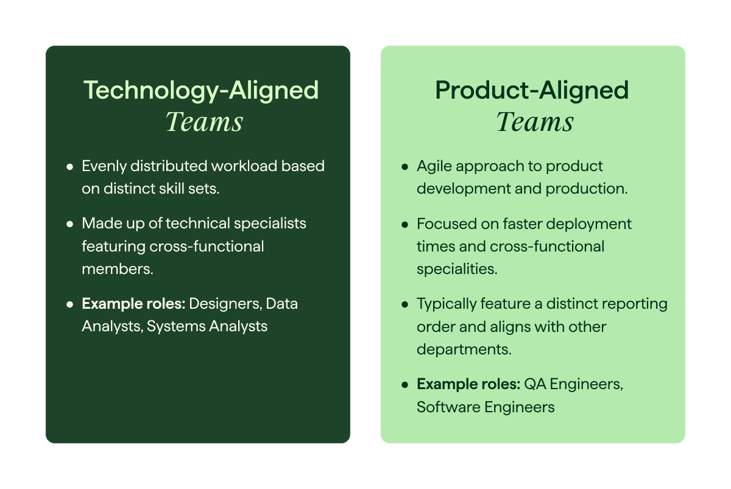Two things are true here.
The first is that there are plenty of highly-skilled, intelligent, and agile developers and engineering leaders out there. (And while we can’t ignore the recent tech layoffs, top-tier engineering talent is still and will continue to be very much in demand.)
The second is that I’ve witnessed firsthand how even the very best engineering talent can still be stifled by a culture that suppresses innovation and lacks a solid team structure.
As Hunt Club’s Sr. Managing Director of Engineering Search who’s specifically built product and engineering teams from the ground up, I’ve come to understand the undeniable importance of team structure and the right roles in place.
On several occasions, I’ve personally witnessed engineering teams work without a clear structure, operating framework, or solid roadmap. And every time, I’ve seen how this led to disastrous results. Without a proper structure or framework in place, I’ve seen:
- Engineers at varying levels and expertise swarm (and rush) to build features instead of software that solves customer problems.
- Unstable, buggy code.
- Complete refactoring or rebuilding.
- Intense teammate frustration and lost trust.
- Major delays in time-to-market and revenue generation.
Don’t get me wrong, I am a huge proponent of agile frameworks and understand that you have to fail forward. However, assembling a team without a proper structure and the end in mind can have some seriously dire consequences.
In this article, I’m going to cover how most engineering teams are structured today, why it’s important to have a solid team structure in place, and how to actually build those teams with key roles.
Let’s get started!

Need help building your engineering teams? I specialize in helping startups and enterprises alike hire top-tier engineering professionals. Hunt Club’s network recruiting model helps us reach the elusive engineering candidates other traditional recruiters don’t have access to. Get the best talent, from the best talent. Connect with me on LinkedIn to learn more, or get started today.
How Are Engineering Teams Structured?
Engineering teams are unique in their structure because of the nature of their work. Arguably, their work interacts with almost every business touchpoint. From speaking directly to customers and external stakeholders to delivering new products that streamline the work of other departments, engineering teams must be adequately equipped and structured to adapt to the organization’s shifting needs and priorities at any given moment.
This requires exceptional coordination, project management, and ultimately, outstanding teamwork.
To be set up for success, engineers are typically organized into the following main teams.

Technology-Aligned (Horizontal) Teams
In a technology-aligned (horizontal) engineering team, individual members have defined roles with an evenly-distributed workload based on their unique skill sets. There isn’t a hierarchy of power or seniority, but an equal distribution of responsibilities that all push toward their shared goal(s). Technology teams are usually made up of technical specialists.
Here are just some example roles that fall under a technology-aligned team:
- Designers
- Data Analysts
- Data Scientists
- IT Security Engineers
- Systems Analysts
Product-Aligned (Vertical) Teams
Product-aligned (vertical) teams instead use an agile approach to product development and production. These teams are focused on faster deployment times, cross-functional specialties, and typically have a distinct reporting order. Vertical teams are also seen aligning and forging critical partnerships with other departments and/or third-party vendors to expedite product and software development.
Some example roles that fall under a product-aligned team include, but are not limited to:
- QA Engineers
- Product Managers
- Project Managers
- Software Engineers
Hub & Spoke Teams
The hub and spoke team structure is a balanced blend of technology and product teams. Hub and spoke teams are usually cross-functional and report to several different managers within the team instead of just one.
In a hub and spoke team, there’s a centralized team (hub) that governs the data, analytics/metrics, and strategy, and there are distributed teams (spokes) that carry out distinct functions and operations (e.g., tech sales, R&D, communications, etc.).

The Importance of Structure in Engineering Teams (Main Benefits)
Now that I’ve covered the common ways engineering teams are structured, let’s talk about why even having a solid structure in place is necessary.
Not only does a solid team structure provide a psychologically safe environment in which engineering professionals can do their very best work, it also helps:
- Bring much-needed balance to every team member’s workload.
- Navigate an ever-evolving product roadmap.
- Maximize effectiveness through every iteration.
- Expedite decision-making to move projects along.
- Reduce miscommunication and conflict amongst cross-functional teams.
- Increase output and efficiency.
- Prevent excessive overhauls and constant bug fixes.
6 Tips on How To Structure and Scale an Engineering Team
As your engineering team evolves and grows, you have to ensure you have a solid structure in place and feasible plans for scaling.
What happens when your small team suddenly scales from ten people to 50 or even 100? How will competing tasks and new projects be prioritized? How will this impact your team’s ability to test and iterate quickly? How can you ensure efficiency and empower others to lead, so you can focus on the highest priority items?
Here are six tactics I’ve seen work when structuring and scaling an engineering team.
1. Know Exactly When and How To Grow
You’ll need to have a solid idea of when exactly your team should grow. You should be able to confidently identify milestones or metrics in which your team is ready to expand.
For instance, you need to know when and how to move from a single manager to a second-line manager to eventually 50+ people.
This directly ties into the unique business stage your company is in as well. For example, your hiring and scaling needs will look a little different if you’re in the early stage, growth stage, or an established enterprise. Additionally, your funding attached to any stage will greatly influence and impact the scalability of your engineering team.
Regardless, you have to be keenly aware of where exactly your engineering team is starting and where it’s headed.
Engineering teams have a unique evolution and scale, and team leads have to adapt to it and recognize the signs for growth. To do this, you might:
- Create time-driven benchmarks for when you’ll need to start hiring.
- Identify specific “triggers” for making new hires/promoting within, etc.
- Collect data and feedback on individual and team workloads.
- Ask your team where they experience the most bottlenecks or delays.
In the case where leaders and/or teams wait too long to change, they’ll often be outpaced by their growing company, and it’s in this gap where I’ve seen many engineering teams have to restructure — again.
2. Evaluate Your Current Team Members’ Skills and Strengths
In order to effectively build and scale your team, you need to know all the pieces you have.
Take a look at your unique team dynamic. What type of players do you have? What types of engineers are on board? What programming languages are a part of your team’s tech stack? Knowing this information can help you put the right players in the right teams before you do anything else.
Another great way to structure and scale your engineering team is by looking for its blind spots. Once you have a good understanding of what you do have, look for what you’re missing.
Are there team members you can bring on to bridge any knowledge or skills gaps? Can you roll out specific trainings to upskill your team?
3. Adapt to Asynchronous Work
In the time of remote work — and especially in an engineering team — being able to work asynchronously is paramount. If it’s not already a part of your company culture, make sure your engineering team is set up for success by building a structure that actively supports asynchronous work.
Engineers can often find themselves working independently, focusing especially on maximizing output, coding, fixing bugs, and other autonomous tasks.
Structure your team considering this. Some tactics I’ve seen work in this area include:
- Utilizing real-time communication tools like Slack.
- Scheduling all-hands think-tank meetings where everyone can join.
- Strategically building teams based on team members’ geographic locations/time zones (all iOS engineers in one time zone, etc.).
4. Consider the Customer
This one’s simple but perhaps the most important.
Focus everyone on the long-term vision of what you want to build and who you’re building it for. The who of it all should remain the constant pillar in any engineering team structure.
This is the hallmark and key responsibility of a great engineering leader. It’s their role to ensure the who is always being used as the lens for product development, UX, updates, and more.
So instead of building and scaling your team around ad hoc projects or new business initiatives (this might lead you to hire one-off contractors, etc.), focus on building and scaling teams around the current and future needs of the end-user.
You’ll find that once the who is at the center of your team’s mission, the rest falls more easily into place.
5. Over-Communicate and Establish Shared Goals
Engineering teams need to be structured on a foundation of full transparency and common goals. Engineers are inherently output-driven, and this leaves little room for miscommunication, misalignment of goals, or other gaps.
If you want your engineering team to scale effectively and reduce duplication of work, make sure to conduct regular check-ins, check for dependencies to eliminate bottlenecks, and always over-communicate.
6. Monitor and Modify as Needed
Engineering teams are all about iteration, innovation, and continuous improvement. Make sure you’re structuring your teams the same way by closely monitoring the effects of your decisions and collecting specific team metrics (e.g., team member retention, the number of senior-level vs. junior-level staff, etc.).
Key Engineering Roles To Hire For
I’ve covered how engineering teams are structured as well as six practical tips on how to go about actually structuring them.
Now, let’s switch gears to the vital roles engineering teams should have in place to be the most effective, balanced, and successful.
Chief Technology Officer (CTO)
In any engineering team structure, a Chief Technology Officer helps marry the team’s product goals with overarching business needs. CTOs are the senior executive leaders responsible for integrating a company’s products and technology into its core services.
CTOs are critical to the success of an engineering team as they ensure all teams — whether vertical or horizontal — are completely aligned in their pace, product roadmap, timelines, and innovation.
The best CTOs not only establish goals, set the tone, and establish team culture, they have the technical expertise and chops to step in wherever needed. For example, a top CTO should be able to step in to fix bugs and improve code without missing a beat.
Chief Information Security Officer (CISO)
Think of your Chief Information Security Officer as your engineering team’s guard. They’re a critical line of defense for your organization’s sensitive data and information. CISOs are top-level executives who are responsible for developing and implementing a robust information security program that protects the entire company’s data and systems.
They work closely with other C-level executives, with a special focus and ability to manage risk and compliance and monitor data threats. They know how to detect and recover from data breaches, coordinate responses to security threats, and implement policies and procedures to best protect an organization’s information and assets.
CISOs will typically have a strong background in information security, computer engineering, computer science, network security, and other related fields.
The best CISOs, however, will create an intelligent framework for scaling your team even in a risk-prone environment.
VP of Engineering
VPs of Engineering are responsible for the day-to-day leadership and management of large engineering teams. They provide direct supervision and direction to teams, as well as work closely with the COO and CISO to develop a technical roadmap that aligns with the business’s overall strategy.
While VPEs oversee the management, growth, and cash flow of the department, top VPs of Engineering should also be able to step in and fully utilize their technical expertise to resolve complex coding issues and bugs. You’ll also often see the best VPEs working with all types of teams or spokes (product, design, sales, marketing, etc.) to better unify and align the goals of the engineering department with the rest of the organization.
Software Engineering Manager
Your software engineering manager is a critical team lead. They often act as the head of the team working on specific software development and help guide other engineers and technical staff.
Not only can they design and update software applications themselves, they have a special focus on training other engineers, project management, preparing and analyzing technical reports, and ensuring all team members stick to best practices.
Full Stack Engineer(s)
Full-stack engineers are a pillar in any engineering team. The term “full-stack” refers to an engineer’s ability to be on both the front and back end of a product’s development.
A full-stack engineer develops, tests, and implements various software applications. They’re highly versatile engineers with the ability to build software, web and mobile applications, and more. They’re often involved in every stage of software development and a product’s roadmap. This might mean they’re involved in designing the UX, troubleshooting bugs, and even leading other front and backend developers in their projects.
They’re also typically advanced coders and well-versed in several programming languages such as:
- Node
- JavaScript
- HTML/CSS
- Python
- C
- SQL
Frontend Engineer(s)
Frontend engineers deal with the parts of a website, application, or software that end-users actually interact with and see. They’re responsible for making websites and apps functional, accessible, and engaging. They’re involved in things like page speed, optimizations, UX testing, and actual performance.
At the end of the day, you’re building products and software that can be used and used well. Your frontend engineers will see to it that they are.
Backend Engineer(s)
Think of your backend engineer as the team’s backbone. While not technically customer-facing, they’re responsible for developing the very skeleton and structure of a software application your customers use. They deal with everything on the “backend” or server-side of an application. From developing clean code to resolving complex bugs, backend developers set the path for the team.
Backend engineers:
- Test, analyze, and scale backend software features like APIs, servers, and databases.
- Fix structural technical problems of varying complexity and scopes.
- Make improvements and upgrades to existing code.
- Write high-quality code with special attention to precision and long-term use.
iOS & Android Engineers
Mobile engineers develop and implement software for mobile devices and technologies. They’re typically specialists in specific operating systems like iOS or Android and work closely with other engineers and stakeholders to launch innovative apps and functions.
And considering the fact that 97% of Americans own a mobile device/cell phone of some kind, your mobile engineers are integral to the success of your overall team and business.
Data Architects
You can’t have an engineering team structure without the work of a data architect. All engineering teams can benefit from data architects and their ability to define policies, models, and technologies used to access sensitive company data.
Data architects often work closely with the VPE and CISO to communicate critical data usage requirements and technology applications. They’re critical to defining and providing the framework for data standards and principles. Without them, many engineering teams risk compliance, the work of data engineers, and overall data systems.
Hunt Club Can Help You Recruit Top Engineering Candidates
Any good team is forged within a structure. Every player has their role, and they each help push toward one shared goal.
Whether you need to fill in a critical engineering role or build a new team from the ground up, Hunt Club can connect you with the top talent.
We specialize in recruiting the best engineering candidates needed to help teams build products faster and constantly innovate.
Here's a snapshot of the recent companies and roles we've helped build engineering teams for:
- Lucra: Backend Lead, Director of Product Management
- Luminate: Director of IT, VP of Product Management
- Greenlite: Director of Software Engineering
- Tracer: SVP of Engineering
- GLD: Frontend Developer
- Tovala: VP of Software Engineering
- ReversingLabs: Director of Field Threat Engineering
- FLYR: VP of Engineering, Platform
Leveraging our network-based recruiting model and automated sourcing technology, Hunt Club is uniquely positioned to find your next engineering executive or professional quicker than traditional recruitment methods. Our vast network allows us access to hundreds of top CTOs who can introduce us to your next critical engineering hire.
Connect with me or learn more about how we can help build, structure, and scale your engineering team.






